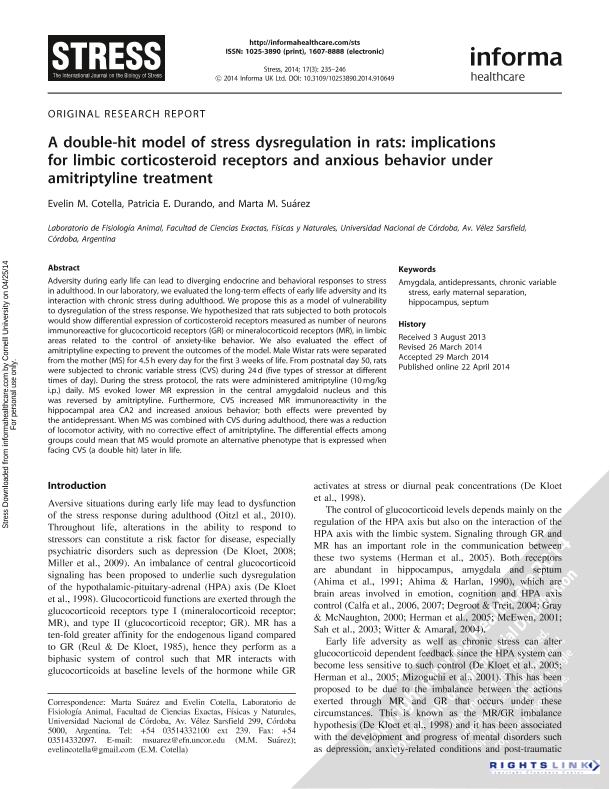Mostrar el registro sencillo del ítem
dc.contributor.author
Cotella, Evelin Mariel

dc.contributor.author
Durando, Patricia Evelina

dc.contributor.author
Suarez, Marta Magdalena

dc.date.available
2017-12-27T13:57:48Z
dc.date.issued
2014-05
dc.identifier.citation
Durando, Patricia Evelina; Cotella, Evelin Mariel; Suarez, Marta Magdalena; A double-hit model of stress dysregulation in rats: implications for limbic corticosteroid receptors and anxious behavior under amitriptyline treatment; Taylor & Francis Ltd; Stress; 17; 3; 5-2014; 235-246
dc.identifier.issn
1025-3890
dc.identifier.uri
http://hdl.handle.net/11336/31628
dc.description.abstract
Adversity during early life can lead to diverging endocrine and behavioral responses to stress in adulthood. In our laboratory, we evaluated the long-term effects of early life adversity and its interaction with chronic stress during adulthood. We propose this as a model of vulnerability to dysregulation of the stress response. We hypothesized that rats subjected to both protocols would show differential expression of corticosteroid receptors measured as number of neurons immunoreactive for glucocorticoid receptors (GR) or mineralocorticoid receptors (MR), in limbic areas related to the control of anxiety-like behavior. We also evaluated the effect of amitriptyline expecting to prevent the outcomes of the model. Male Wistar rats were separated from the mother (MS) for 4.5 h every day for the first 3 weeks of life. From postnatal day 50, rats were subjected to chronic variable stress (CVS) during 24 d (five types of stressor at different times of day). During the stress protocol, the rats were administered amitriptyline (10 mg/kg i.p.) daily. MS evoked lower MR expression in the central amygdaloid nucleus and this was reversed by amitriptyline. Furthermore, CVS increased MR immunoreactivity in the hippocampal area CA2 and increased anxious behavior; both effects were prevented by the antidepressant. When MS was combined with CVS during adulthood, there was a reduction of locomotor activity, with no corrective effect of amitriptyline. The differential effects among groups could mean that MS would promote an alternative phenotype that is expressed when facing CVS (a double hit) later in life.
dc.format
application/pdf
dc.language.iso
eng
dc.publisher
Taylor & Francis Ltd

dc.rights
info:eu-repo/semantics/openAccess
dc.rights.uri
https://creativecommons.org/licenses/by-nc-sa/2.5/ar/
dc.subject
Amygdala
dc.subject
Antidepressants
dc.subject
Chronic Variable Stress
dc.subject
Early Maternal Separation
dc.subject
Hippocampus
dc.subject
Septum
dc.title
A double-hit model of stress dysregulation in rats: implications for limbic corticosteroid receptors and anxious behavior under amitriptyline treatment
dc.type
info:eu-repo/semantics/article
dc.type
info:ar-repo/semantics/artículo
dc.type
info:eu-repo/semantics/publishedVersion
dc.date.updated
2017-12-26T20:40:09Z
dc.journal.volume
17
dc.journal.number
3
dc.journal.pagination
235-246
dc.journal.pais
Reino Unido

dc.journal.ciudad
Londres
dc.description.fil
Fil: Cotella, Evelin Mariel. Universidad Nacional de Córdoba. Facultad de Cs.exactas Físicas y Naturales. Departamento de Fisiología. Cátedra de Fisiología Animal; Argentina. Consejo Nacional de Investigaciones Científicas y Técnicas; Argentina
dc.description.fil
Fil: Durando, Patricia Evelina. Universidad Nacional de Córdoba. Facultad de Cs.exactas Físicas y Naturales. Departamento de Fisiología. Cátedra de Fisiología Animal; Argentina. Consejo Nacional de Investigaciones Científicas y Técnicas; Argentina
dc.description.fil
Fil: Suarez, Marta Magdalena. Universidad Nacional de Córdoba. Facultad de Cs.exactas Físicas y Naturales. Departamento de Fisiología. Cátedra de Fisiología Animal; Argentina
dc.journal.title
Stress

dc.relation.alternativeid
info:eu-repo/semantics/altIdentifier/doi/http://dx.doi.org/10.3109/10253890.2014.910649
dc.relation.alternativeid
info:eu-repo/semantics/altIdentifier/url/http://www.tandfonline.com/doi/full/10.3109/10253890.2014.910649
Archivos asociados
